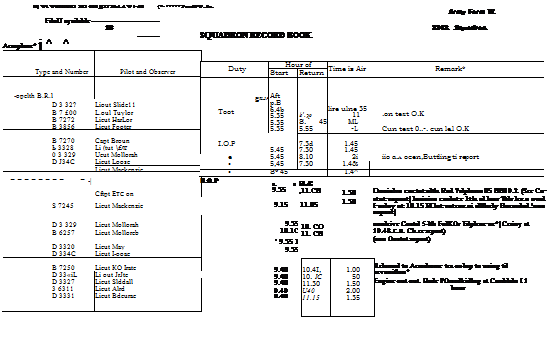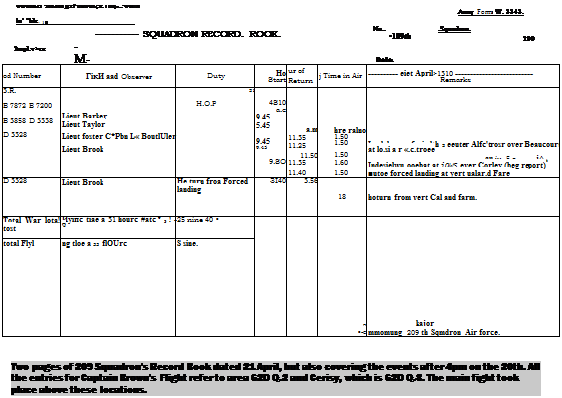209 Squadron — The Second Claim
The pages of209 Squadrons Record Book which were submitted to 22 Wing at the end of 21 April, showed that 15 pilots, divided into three flights, left Bertangles at 0935,0940 and 0945 hours:
A FLIGHT
Captain A R Brown DSC B7270
Lieutenant W J Mackenzie B7245
Lieutenant W R May 1)3326
Lieutenant L F Lomas D3340
Lieutenant F J W Mellersh D3329
В FLIGHT
Captain О C LeBoutillier D3338 Lieutenant R M Foster B3858 Lieutenant M A Harker B7272 Lieutenant M S Taylor B7200 Lieutenant C G Brock B3328
C FLIGHT
Lieutenant О W Redgate B7250
Lieutenant A W Aird B6311
Lieutenant E В Drake 1)3345
Lieutenant C G Edwards D3331
Lieutenant J H Siddall 1)3327
As far as Wing HQ was concerned a squadrons day began at 1601 hours on one day and ended at 1599 hours the following day, not midnight to midnight. The pages of the various record books, depending on how busy a unit had been, might cover one page one day, several days or merely a few hours. In the case of 209 Squadron at this period, their Record Book page covers both the 20th and 21st, while the 21st also spills over onto a second page covering the 21st only, while the subsequent page covers later events of the 21st and then the 22nd (see page 33).
Upon reaching their assigned altitude, the three flights patrolled the front to discourage any German photographic reconnaissance aircraft from trying to cross the lines. Eventually Redgate s flight became separated from the others by cloud and a little later two of his pilots were forced to return to Bertangles due to engine problems. Redgate and his remaining two men patrolled until the end of the allotted time and then returned to base.
Around K)2(l hours. LeBoutillier s flight saw a
German two-seater recce machine over Beaucourt at 12,000 feet and Lieutenant Merril Taylor, a Canadian, shot it down. Before hitting the ground it caught fire. He identified it as an Albatros C – type but it was probably a Rumpler or LVG CV crewed by Leutnant Kurt Fischer and Leutnant Rudolf Robinius, of FAA203, who were both killed. They came down near Ignaucourt, just to the north-west of Beaucourt, the location given by Taylor for the combat. From a distance. Captain Brown saw the action, followed by an aircraft descending in flames. His testimony was used to confirm Taylors claim.
Here fate took a hand and the path of Captain Browns depleted Squadron crossed with that of Jasta 11. That morning, with von Richthofen leading, they had been joined by a few machines from Jasta 5, Triplanes and Albatros Scouts. At about 1040 hours British time battle was joined in the area of the town of Cerisy, map reference
62D. Q.3.
Both Brown and von Richthofen had a similar habit which endeared them to their subordinates After leading an attack, each would detach himself from any combat which followed, climb above it and be ready to go to the aid of any pilot who was in a tight spot. Von Richthofen even carried a pair of small binoculars on a cord around his neck for better identification of distant aircraft.
Having re-formed themselves after the engagement with the two RE8s, the Fokker Triplanes were once more patrolling behind the German lines looking for British aircraft. Von Richthofen had rejoined and was at the head of one Kette (Flight), flying with his cousin, Leutnant Wolfram von Richthofen, Oberleutnant Walther Karjus, Vizefeldwebel Edgar Scholz and Leutnant Joachim Wolff. It is not known for certain who was leading the second Kette following Weiss’* departure, but one of the pilots was Leutnant Richard Wenzl, formally of Jasta 6. The Fokker pilots saw five Camels coming up from the south, approaching Le Hamel. These were Brown and his four companions. Wolff noted that the Jasta 5 machines were about four kilometres to the north-east, over Sailly-le-Sec, just the other side (north) of the Somme. Moments later Wenzl saw
 |
 |
another Flight of Camels – Le Boutillier s В Flight.
The formations met. Lieutenant Mackenzie, of Brown’s flight, was taken by surprise and wounded early in the fight; perhaps this was Wolffs claim. Mackenzie turned to face his attacker and claimed to have shot him down. He then left the battle and headed back to Bertangles where he landed safely although in the Record Book his landing time is the same as Brown and Co. His copy of the combat report that went to Brigade is interesting because later that afternoon Major Butlers annotation in ink ‘decisive’ was amended in pencil either by 22 Wing or by 5th Brigade, with the prefix ‘In-’ so that the final decision on his claim became ‘indecisive’.
Lieutenant Francis Mellersh. also in Brown’s flight, was engaged by two Triplanes, possibly Joachim Wolff and Walther Karjus, who had him out-manoeuvred. Brown saw this and rescued him successfully. These are the two Triplanes Brown refers to both in his combat reports and log book, almost as an afterthought. Clear of immediate danger, Mellersh fired at a Fokker with a blue tail near Cerisy. He made his first mistake by following it down to be sure of his victory. Two other Triplane pilots saw this and. realising that the attacking Camel was following a predictable flight path (Mellersh’s second mistake), angled down to intercept him. The blue-tailed Triplane, which could not have been from Jasta 11, but more likely from Jasta 5, force landed near Cerisy but as neither unit suffered any fatalities – or men wounded, it is difficult to comment. Mellersh. having become unexpectedly otherwise engaged, claimed the Triplane as ‘having crashed’ in his combat report, and perhaps believed it had. Only Vfw Scholz is known to have been shot up but he returned safely.
In the action were pilots of varying degrees of experience, but two of them stood out, one a Canadian, the other a German. Lieutenant Wilfred Reid ‘Wop’ May, from Edmonton. Alberta, was a month past his 24th birthday. He had joined 209 Squadron this very month, so was still finding his feet, very much the novice. On the other side. Wolfram von Richthofen, aged 22, from Barzdorf, Silesia, and like his famous cousin, a former cavalry (Hussar) officer, had joined Jasta 11 on 4 April, so he too was very much a new boy. Both men had been warned to stay clear of any action and that if danger loomed, they were to break off and head for home – fast.
When the main fight erupted. Wop May, as instructed by his friend and flight commander, Roy Brown (they had known each other back in
Canada), edged away but when he saw a Triplanc tantilisingly close by. decided to take a crack at : This turned out to be Wolfram von Richthofie: himself trying to stay out of trouble. However. :r. r danger to the Fokker pilot had been spotted bv the experienced eyes of the Red Baron, who carne down from his‘guardian angel’position above the fight to help his young cousin. Those de^r. experienced and now concentrating eyes latched onto the Camel. There can be little doubt that the Baron, while intent on saving his cousin, was noting mentally his approaching 81st kill.
It was only May’s third patrol into enerr74- territory and his second taste of combat. For h an inexperienced pilot to encounter the seasor. r.: airmen of Jasta 11, supported by Jasta 5. л *:• decidedly unlucky. Although May later stated tha: botli his machine guns jammed in the fight, th:- not mentioned in any documentation of the dav: Such jamming is only mentioned in a report r~. May concerning another action one week late:
Brown had said to May:‘Keep out of any fig-* Stay above it and watch. If an enemy begins : come towards you. head for home.’
Whatever had happened beforehand. May now lost altitude and decided to head for horr; Unfortunately instead of climbing out of the battle as he should have done, he put the Can.; – nose down a little for more speed and followed і predictable flight path. Two airmen saw this Manfred von Richthofen and Roy Brown.










